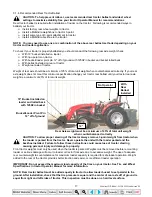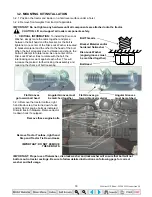
7
SAFETY PRECAUTIONS
79. High pressure oil leaks can penetrate skin causing serious injury and gangrene. Consult a physician
immediately.
80. Lower the loader or boom and release hydraulic pressure before loosening fittings.
AFTER OPERATION
81. Before leaving the tractor seat, lower attachment or loader boom to ground, stop engine, lock parking
brakes, put all controls in neutral, relieve hydraulic pressure, and remove key before leaving operator's
seat.
82. Before disconnecting hydraulic lines, relieve all hydraulic pressure.
83. Make sure all parked loaders on stands are on a hard level surface with all safety devices engaged to
prevent loader from falling and being damaged or injuring someone.
84. Always park loader with bucket attached to loader.
85. When a front loader is mounted on the tractor, enter and exit the operator’s seat only from left side of the
tractor.
86. Special care should be taken to park or store attachments with points or sharp edges in a safe manner.
87. Make sure all parked loaders are on a hard level surface. Engage all safety devices to prevent loader
from falling and being damaged or injuring someone. Do not repair loader if it is not mounted on the
tractor. Loss of hydraulic fluid or removal of parts could cause loader to collapse resulting in injury.
REPAIR
88. Visually check for hydraulic leaks and broken, missing, or malfunctioning parts.
Make necessary repairs before operation.
89. To keep mounting kit hardware from loosening during loader operation, hardware must be torqued to
specifications noted in operator manual.
90. Always wear safety goggles when servicing or repairing the machine.
91. When servicing or replacing pins in cylinder ends, bucket, etc., always use a brass drift and hammer.
Failure to do so could result in injury from flying metal fragments.
92. Never tow from any point of the loader with a chain, rope, or cable. Doing so could cause a roll over or
serious damage to the loader.
35 Series 4WD, Model - 3535 & 4035 Loader June’08























